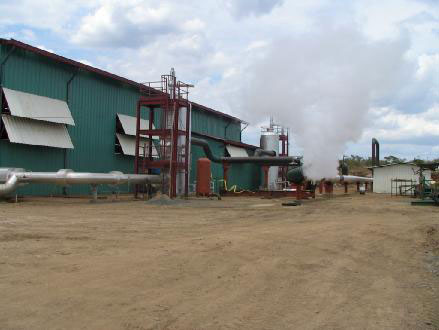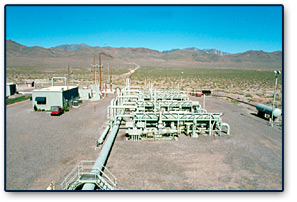
Photo Credit: Polaris Geothermal
Polaris Geothermal recently reported full results for the year 2007. A detailed press release about the earnings is available here. The high points: The company got a full year of production from the Phase I of its plant in San Jacinto-Tizate, Nicaragua at around 7MWe of average output, the drilling program continued to grow Phase I to its planned 34MW target, and the full 72MW of production appears to be on track for the 2010 timeframe.
The low lights involved a question about the validity of the concession from the Nicaraguan government which was resolved and accelerating losses, the net loss rate for the company increased nearly $2M to $6.7M on the year. Shareholder concerns about Polaris have to revolve around project finance where additional dilution and access to debt financing will present distinct challenges going forward.
Rather than making this a straight financial story, one of the things that struck us about this release was the transparency of the operational aspect of the SJC plant. We applaud Polaris for disclosing this information and believe since it is there, at least at this plant on this project, we can see some of the real cost and benefit of geothermal plant operations.
In 2007 the SJC plant produced 64,778 MWh of power accounting for $3.9M in power sales and $0.7M in carbon credit sales for a grand total of $4.6M of revenue for the project. Plant operations expenses totaled $2.2M yielding a gross margin of $2.4M for the project at an average output of 7.37MW per month. Hidden in these numbers are outages of over a week in June which cost the company approximately 1,000 MWh of sales.
We can reverse engineer that the company is being compensated $10.80 per MWh for carbon credits and $60.20 per MWh for power sales against operations cost of $34 per MWh. As the project grows to 34MW and finally tops out at its planned 72MW, these numbers should improve as the plant operations costs won’t scale in a linear fashion relative to output due to economies of scale (after all, the operations infrastructure is in place now, operations cost will increase but the slope should be pretty flat.)
NCPA, an operator at the Geysers, sees operations costs of about $19 per MWh at 132MW of output. It seems reasonable to believe that Polaris could achieve that level of efficiency over time, but even if the SJC project split the difference and only improved to $26.50/MWh, there would still be interesting impacts on the bottom line.
If nothing changes except capacity and output, at a 34MW and present availability and capacity factor, the company would bring in $13.2M in power sales and $2.4M in carbon credits balanced against $7.5M in plant operations producing a pre-tax, pre-corporate expense run rate net of $8.1M. If the company was able to hit the $26.50/MWh operational improvement, that would result in a $1.7M increase to $9.8M.
At 72MW and current operational levels and assumptions, the project is a real money machine producing $28M in power sales and $5M in carbon credits against operational expense of $15.8M. With numbers this attractive, why isn’t everyone building geothermal plants? The answer lies in the development expense. Effectively, the lifetime cost of production is incurred upfront and then amortized over the lifetime of the project. Therein lies the rub, the development cost per MW of output is in the $3.2M range presently meaning to reach 72MW Polaris will likely have spent $230M developing the plant.
It’s always nice to see real numbers, thank you for disclosing Polaris and we wish you well as you build your SJC project out to scale.





